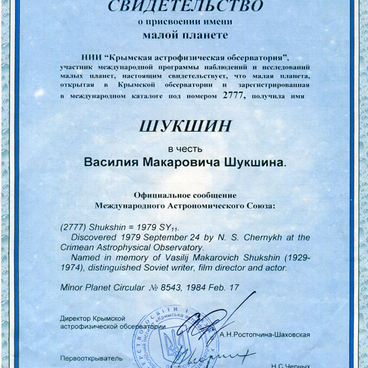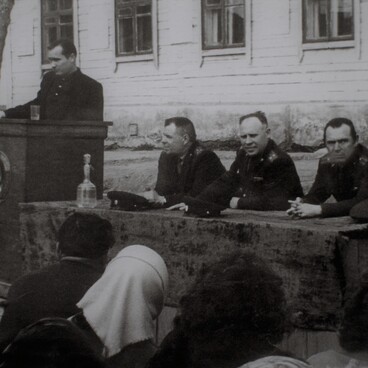On this photograph, Vasily Shukshin (first from the left) is depicted with his childhood friends: Sergey Bedarev, Oleg Bychkov, Ivan Krasnov, and Nikolai Bystrov. The picture was taken in mid-1940’s in Srostki in front of the wall of Pavel Kuksin’s (Shukshin’s stepfather) house.
The house was situated at 8 Kooperativny Lane, in the historic part of the village called “Nizovka”. The distance to Katun river was only 150 meters, while window view covered Popovsky and Gilevsky islands, as well as Talitskaya side.
Shukshin’s circle of friends mainly included boys from Nizovka. Oleg Bychkov, Vasily Ryabchikov, and Alexander Kalachikov lived in Beregovaya Street. Sergey Bedarev resided in Naberezhny Lane. Ivan Krasnov lived in Sovetskaya Street, in across from the old school. Grigory Novoselov resided in Koltsovsky Lane. Many of them served as prototypes for the characters of Shukshin’s short stories, which were based on his memories of childhood and youth. For example, Ryabchikov recalled, “A wartime childhood. It was extremely difficult, hungry, and cold. We had to take constant care of finding food, of finding firewood. I remember how we, a bunch of young lads, used to go at nights (as it was forbidden during the day) to Talitsky birch forest for firewood. Then, we got together to play in the evenings, when we had spare time. Sometimes we walked along the streets in large groups and sang. While playing balalaika. It was considered a good evening, if we had a concertina… We used to read a lot at the time, although we had few books. The books were passed from one person to another. Just for a day or two, one couldn”t keep a book for longer since others were waiting for it. Vasily, Sasha Kalachikov, and I read a lot”.
The house was built in 1908 by Ivan Ponomarev, an old resident of Srostinsky district. In 1938, he was arrested and executed by the decision of NKVD. Soon the owner’s wife died as well. After that the house was split in two parts, each of them had a separate entrance. The Eastern half of the house was given to Ponomarev’s children. However, after they were sent to an orphanage, it became state property. Rural intellectuals lived there over the years.
The Western half of the house was bought by Anna Kuksina. Then, she sold it to her brother, who was Shukshin’s stepfather. In 1935, he married Maria Shukshina. On 1 July 1941, Kuksin left for the frontline and went missing in action. His widow occupied the house from 1941 until 1957. A quite significant period of Shukshin’s life was connected with this house: his studies at school and at Biysk Automotive College, leaving home in 1947, return from military service in December 1952, receiving his matriculation certificate, working as a teacher in an evening shift school during the 1953-1954 academic year, and departure to Moscow in 1954.
The house was situated at 8 Kooperativny Lane, in the historic part of the village called “Nizovka”. The distance to Katun river was only 150 meters, while window view covered Popovsky and Gilevsky islands, as well as Talitskaya side.
Shukshin’s circle of friends mainly included boys from Nizovka. Oleg Bychkov, Vasily Ryabchikov, and Alexander Kalachikov lived in Beregovaya Street. Sergey Bedarev resided in Naberezhny Lane. Ivan Krasnov lived in Sovetskaya Street, in across from the old school. Grigory Novoselov resided in Koltsovsky Lane. Many of them served as prototypes for the characters of Shukshin’s short stories, which were based on his memories of childhood and youth. For example, Ryabchikov recalled, “A wartime childhood. It was extremely difficult, hungry, and cold. We had to take constant care of finding food, of finding firewood. I remember how we, a bunch of young lads, used to go at nights (as it was forbidden during the day) to Talitsky birch forest for firewood. Then, we got together to play in the evenings, when we had spare time. Sometimes we walked along the streets in large groups and sang. While playing balalaika. It was considered a good evening, if we had a concertina… We used to read a lot at the time, although we had few books. The books were passed from one person to another. Just for a day or two, one couldn”t keep a book for longer since others were waiting for it. Vasily, Sasha Kalachikov, and I read a lot”.
The house was built in 1908 by Ivan Ponomarev, an old resident of Srostinsky district. In 1938, he was arrested and executed by the decision of NKVD. Soon the owner’s wife died as well. After that the house was split in two parts, each of them had a separate entrance. The Eastern half of the house was given to Ponomarev’s children. However, after they were sent to an orphanage, it became state property. Rural intellectuals lived there over the years.
The Western half of the house was bought by Anna Kuksina. Then, she sold it to her brother, who was Shukshin’s stepfather. In 1935, he married Maria Shukshina. On 1 July 1941, Kuksin left for the frontline and went missing in action. His widow occupied the house from 1941 until 1957. A quite significant period of Shukshin’s life was connected with this house: his studies at school and at Biysk Automotive College, leaving home in 1947, return from military service in December 1952, receiving his matriculation certificate, working as a teacher in an evening shift school during the 1953-1954 academic year, and departure to Moscow in 1954.

